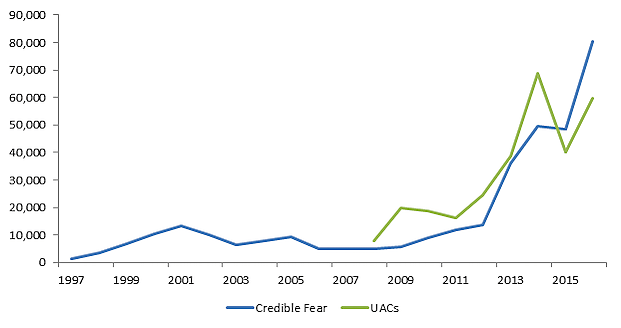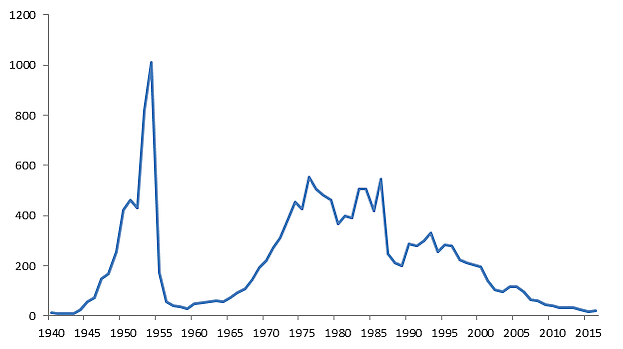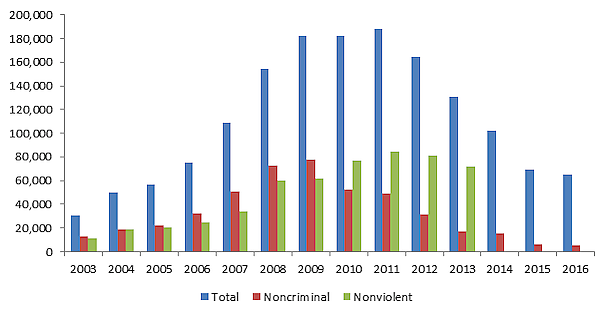President Donald Trump has issued two executive orders on immigration so far—both of them undermine immigrants’ ability to live and work peacefully in the United States. The first focuses on the border crisis, mandating the construction of a virtually pointless border wall and cracking down on asylum seekers, and the second ramps up enforcement against immigrants residing illegally inside the United States. Here are three trends that put these orders in context.
1. The administration will target asylum seekers during the largest U.S. asylum crisis in decades. More people came to the border last year to claim asylum than at any time since the Mariel Boatlift brought 125,000 Cubans to Miami in 1980. Figure 1 provides those numbers back to the 1990s when asylum law was last changed. In addition, it shows the huge number of unaccompanied children who are entering—all of whom are automatically considered asylum seekers and are referred for a formal hearing. The influx reflects the tremendous violence in Central America—specifically, El Salvador, Guatemala, and Honduras. These asylum seekers are not “illegal immigrants.”
They are not attempting to sneak into the United States. They voluntarily turn themselves into Border Patrol at the border. These numbers are somewhat lower than those in a Homeland Security report obtained by the Associated Press that found 170,000 in 2014 and 140,000 in 2015, compared to 120,000 and 90,000 UACs and asylum seekers who made credible fear claims in those years in Figure 1.
Figure 1: Unaccompanied Alien Children (UACs) and Asylum Seekers to the United States Claiming Credible Fear in Home Country (FY 1997–2016)
Sources: Rempell (1997–2008); USCIS (2009–2016)
The border wall executive order seeks to prevent these asylum seekers from having their claims heard. It will “end the abuse of parole and asylum provisions currently used to prevent the lawful removal of removable aliens.” The administration sees asylum law as a loophole to prevent deportations as opposed to a protection to prevent deporting vulnerable people. The order requires new regulations to “ensure that the parole and asylum provisions of Federal immigration law are not illegally exploited.” It is not “exploitation” if the immigrants follow what the regulations require. Changing the regulations to make it more difficult to receive asylum does not end “abuse”—it ends the legal opportunity to receive safe haven in the country.
2. The administration will attempt to construct a border wall during a time with the fewest border crossers since World War II. The only measure of illegal immigration going back decades is the number of people apprehended by the Border Patrol. More apprehensions typically mean more people are attempting to cross, but more agents make it easier to apprehend people, so it is important to control for Border Patrol’s manpower. As Figure 2 shows, the number of people caught per border agent has not been this low since World War II, and it has consistently fallen year after year since 1993.
Last year, each border agent caught only 21 people all year, less than 2 people each month—the lowest level since 1943. Moreover, as previously mentioned, at least 1 in 3 of all of these “apprehensions” came from asylum seekers voluntarily turning themselves over to the agents. By all measures, the border has never been as secure.
Figure 2: Number of Apprehensions Per Border Agent (FY 1940–2016)
Source: Immigration and Naturalization Service, Customs and Border Protection
Nonetheless, President Trump’s executive order requires the construction of a wall along the southern border and the hiring of 5,000 new border agents. While he will need Congress to fund a portion of this order, it is not clear what these agents will be doing, especially if asylum seekers will be summarily removed.
3. The administration will return to targeting non-criminal unauthorized immigrants at a time when deportations are the lowest in a decade. President Obama rightfully earned his reputation as the Deporter-In-Chief for removing far more immigrants from the interior of the United States than any other president in history. But by 2016, the number of removals had dropped to their lowest levels since 2005, as Figure 3 shows. Removals of individuals without a criminal conviction have also fallen to the lowest level since at least 2002.
Figure 3: Immigration and Customs Enforcement (ICE) Removals from the U.S. Interior By Type
Sources: MPI (2003–2013); ICE (2014, 2015, 2016)
This shift occurred thanks to Homeland Security policy memos that instructed agents to focus mainly on convicted criminals and recent border crossers. Although “criminals” included a large number of nonviolent and low-level offenders, it was a positive development. Immigrants who avoided run-ins with the law could mostly live in peace.
Despite President Trump’s post-election promise to focus only on criminal kingpins and “gangbangers,” his executive order on interior enforcement prioritizes the removal of many who have no criminal convictions at all. Indeed, it goes so far as to state that arrests should be made if an immigration officer even believes that the person has committed a “chargeable offense” without actually having been charged. It also prioritizes those who have ever misrepresented their immigration status, which would likely include almost all unauthorized immigrant workers and the 40 percent or so of immigrants who overstayed visas.
These priorities are actually more expansive than the Obama-Bush policies of 2008 to 2012, which could mean that they will cause interior removals to more than triple their current level. It is worth emphasizing that these expansive policies will consume resources that could be dedicated to removing criminals.



